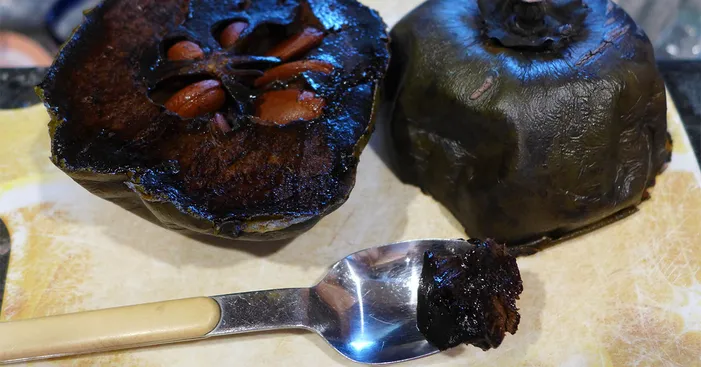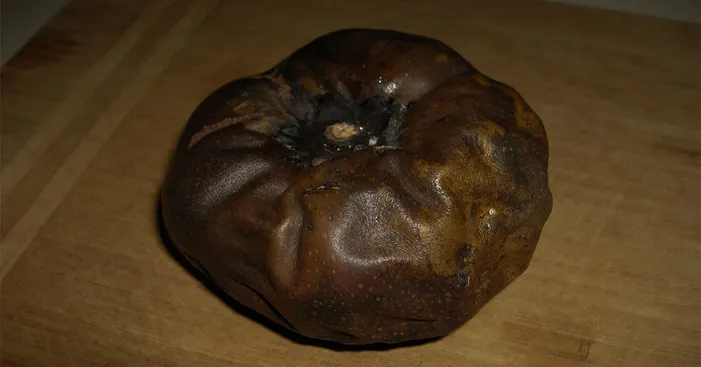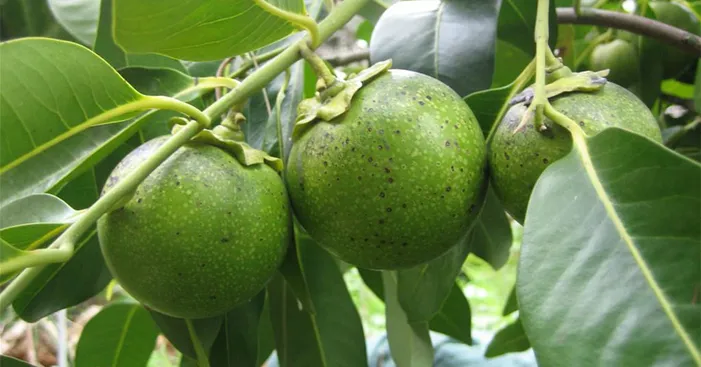Table of Contents

Imagine a fruit that tastes like chocolate pudding, with a rich, creamy texture and a slightly sweet flavor.
That’s the black sapote, a unique and delicious fruit that’s native to Central and South America.
Black sapote is also known as chocolate pudding fruit, black persimmon, or zapote.
It’s a round or oval fruit with smooth, dark skin and soft, orange flesh.
The flesh has a custard-like texture and a rich, chocolatey flavor.
Black sapote is a good source of vitamins and minerals, including potassium, vitamin C, and vitamin A.
It’s also a good source of fiber.
In this blog post, we’ll explore the many benefits of black sapote and how to incorporate it into your diet.
General facts about black sapote:

The sapote, a tropical fruit from the sapodilla tree, is cherished in Central America and other exotic locales.
This avocado- or persimmon-like fruit, 2 to 4 inch in diameter, has a sweet flesh that ranges in color from white to black.
Sapotes are typically eaten fresh, but can also be used to make smoothies, ice cream, and other desserts.
Sapotes have been cultivated in Mexico for centuries, and their sweet, creamy flesh has made them a popular food and ingredient in many Central American cultures.
Today, sapotes are grown in many other tropical and subtropical regions around the world, including Southeast Asia, South America, and the Caribbean.
When ripe, sapotes are soft to the touch and have a slightly sweet aroma.
The flesh is custard-like and can be eaten on its own or used to make a variety of dishes.
Sapotes are often used in desserts, such as ice cream, milkshakes, and cakes.
They can also be used to make savory dishes, such as salads and soups.
Different types of sapote:

Sapote is a delicious and diverse fruit, with different varieties that offer a range of colors, flavors, and textures.
Classic sapote:
also known as Pouteria sapota, is a member of the Sapotaceae family.
It has rough, brown skin and orange flesh.
The flesh is sweet and juicy, with a slightly musky flavor.
White sapote:
also known as the Mexican apple.
It is a member of the Rutaceae family, and its skin color changes from green to yellow when ripe.
The white pulp has a mild flavor, reminiscent of papaya.
It is important to note that consuming large quantities of white sapote can cause drowsiness.
Black sapote:
This type is a unique and exotic fruit that comes from a tropical tree in the ebenaceae family.
It is easily recognized by its black skin and flesh.
The flesh is sweet and creamy, with a chocolaty flavor that is similar to chocolate pudding.
Immature black sapote fruit has a smooth, green skin and is reminiscent of a young tomato.
Flavor of black sapote:

it is generally sweet and creamy, with a soft, smooth texture.
Some people describe it as tasting like ice cream, vanilla, or banana, while others find subtle notes of caramel or coconut.
Black sapote is milder and sweeter than mamey sapote, which can have a more complex flavor and hints of cinnamon.
Overall, sapote is an exotic fruit with a unique and pleasing taste that can be enjoyed in a variety of ways.
Black sapote nutritional values and health benefits:

Nutritional values:
100 grams of black sapote flesh contains approximately:
- Water: 80 g
- Protein: 0.6 g
- Carbohydrates: 13 g
- Fat: 0.01 g
- Iron: 0.36 mg
- Riboflavin: 0.03 mg
- Ascorbic acid: 191.7 mg
- Calcium: 22 mg
- Phosphorus: 23 mg
- Vitamin b3: 0.2 mg
- Carotene: 0.19 mg
Health benefits:

In addition to its delicious taste, the black sapote is also a nutritional powerhouse, packed with vitamins, minerals, and other beneficial compounds.
Excellent Source of Vitamin C:
The black sapote is an excellent source of vitamin C, with a 100-gram serving providing 25% of the recommended daily value (DV).
Vitamin C is essential for several bodily functions, including immune system support, collagen production, and wound healing.
Vitamin A Intake:
The black sapote is also a good source of vitamin A, providing 10% of the DV per 100-gram serving.
Vitamin A is important for vision, cell growth, and immune function.
Promotes weight loss:
Black sapote is a tropical fruit that is packed with nutrients, including carotenoids and catechins.
These nutrients help to release fat from fat cells and help the liver convert fat into energy.
Black sapote is also very low in fat and high in carbohydrates, making it a good choice for people on a weight-loss diet.
A 100-gram serving of black sapote contains only around 80 calories.
This makes it a much lower-calorie option than many other fruits, such as bananas and avocados.
Black sapote is also a good source of fiber, which helps to keep you feeling full and satisfied.
Prevents Anemia:
The black sapote’s vitamin C content can help to prevent anemia by improving the absorption of iron from plant foods.
Iron is essential for the production of hemoglobin, the protein in red blood cells that carries oxygen throughout the body.
Hypertension:
A black sapote leaf infusion is used in Central America to normalize blood pressure levels.
The fruit’s leaves contain compounds that have been shown to relax blood vessels and lower blood pressure.
Insomnia and anxiety:
Black sapote bark and fruit skin are boiled together to create a calming tea that can help relieve insomnia and anxiety.
The tea contains compounds that have sedative and anxiolytic effects.
Pain relief:
An infusion made from black sapote bark, leaves, and no more than 5 seeds can be used to relieve pain from headaches, toothaches, colic, and even scorpion stings.
The seeds contain compounds that have anti-inflammatory and analgesic effects.
Insomnia and anxiety:
In Michoacán, Mexico, black sapote is used to calm nerves and anxiety by drinking a tea made with the bark and sapote blanche at night.
Colon cancer prevention:
Recent studies have linked black sapote consumption to the prevention of colon cancer.
Skin and hair health:
In Central America, black sapote seed oil is used as a skin tonic and to promote hair growth.
Precautions before you consume back sapote:

Black sapote, like any other fruit, has side effects, so it’s important to be aware of them before consuming it.
Some people may be allergic to black sapote, which can cause reactions such as rashes, itching, or even nausea.
If you experience any of these symptoms after eating black sapote, stop eating it immediately.
Black sapote can also interfere with certain medications, so people who are taking medication should avoid eating it.
This is because black sapote can reduce the effectiveness of some medications.
Finally, black sapote is a complex carbohydrate, so it can raise blood sugar levels.
This means that people with diabetes should avoid eating black sapote.
Using black sapote:

Black sapote is a sweet and versatile fruit from Latin America that can be enjoyed in many ways.
Raw, with a spoon or spread on bread, a few drops of lemon enhance its flavor.
Blend it into milkshakes, fruit juices, and cocktails, or add it to desserts such as cakes, compotes, entremets, mousses, and ice creams.
Black sapote is particularly appreciated for its chocolaty taste, and can easily replace chocolate in desserts to lighten recipes.
You can also grate the stone of the fruit to enhance the taste of desserts or to make crème de sapote liqueur.
To eat sapote raw, simply cut the fruit in half, remove the stone, and scoop out the pulp with a spoon.
You can eat sapote on its own, or with fresh fruit, yogurt, or whipped cream.
Sapote pulp can also be used in cooking to add flavor and texture to a variety of dishes.
Try adding sapote to pies, cakes, creams, sauces, dressings, or marinades. Sapote can also be used to make smoothies or juices.
For a refreshing treat, blend sapote pulp with milk, coconut milk, or cream to make ice cream or sorbet.
Black Sapote Ice Cream (Vegetarian Version):

Preparations:
- 1/4 liter of black sapote pulp
- 1 dash salt
- 2 tablespoons cold water
- 600 ml whipping cream
- 190 ml sugar
- 1 teaspoon agar (gelatin substitute)
- 3 tablespoons boiling water
Preparations:
- Soak the agar in cold water for at least 10 minutes.
- Mash the black sapote pulp until smooth.
- Add the sugar to the black sapote pulp and mix well.
- Heat the boiling water in a small saucepan and add the agar. Stir until the agar is completely dissolved.
- Add the agar solution to the black sapote pulp and mix well.
- Chill the black sapote mixture in the refrigerator until it thickens.
- Beat the whipping cream until stiff peaks form.
- Gently fold the whipped cream into the black sapote mixture.
- Pour the ice cream mixture into a freezer-safe container and freeze for at least 4 hours, or overnight.
Black Sapote Muffins:

Ingredients:
- 2 tablespoons softened butter
- 3/4 cup sugar
- 1 egg
- 1 cup black sapote pulp
- 1/3 cup orange juice (optional)
- 2 cups self-rising flour
- 1 teaspoon vanilla extract
Preparations:
- Preheat oven to 220°C (425°F). Grease and flour a muffin tin.
- In a large bowl, combine the butter, sugar, egg, black sapote pulp, orange juice (if using), and vanilla extract. Beat until smooth.
- Add the flour and gently fold until just combined.
- Pour the batter into the prepared muffin tin, filling each cup about 3/4 full.
- Bake for 15-20 minutes, or until a toothpick inserted into the center of a muffin comes out clean.
- Let the muffins cool in the pan for a few minutes before removing them to a wire rack to cool completely.
Storing black sapote:

Black sapote fruit is a delicious and nutritious tropical fruit, but it can be tricky to store.
To ensure that your black sapotes are ripe and flavorful, store them at room temperature until they are soft to the touch and have dark olive-green skin.
Refrigeration can slow down the ripening process and affect the flavor of the fruit, so it is best to avoid putting black sapotes in the fridge until they are fully ripe.
Once your black sapotes are ripe, you can enjoy them fresh or use them in a variety of recipes.
Buying black sapote:

Many of those who have tried it recommend that future consumers of black sapote pay close attention to its degree of ripeness.
If sapote is eaten too early, its flesh will be acidic and inedible.
To make sure you don’t make a mistake, you can tell whether it’s safe to eat by the color of its skin.
Bright green, a sign that the fruit is not yet ripe, the skin becomes paler and paler, until it turns yellow or brown.
The soft texture is another sign of ripeness: you can taste it.
Once you’ve opened the fruit, if it’s ripe enough, you’ll see intense, shiny black flesh, as if it were pitch.
It will probably seem rotten, but don’t be fooled by appearances: this is the degree of perfect ripeness at which the fruit unleashes its full gustatory potential.
Conclusion:
Black sapote is a delicious and nutritious tropical fruit that offers a variety of health benefits.
It is rich in nutrients, fiber, and antioxidants, which can help maintain good digestive, immune, skin, and heart health.
Sapote can be eaten in a variety of ways, including raw, cooked, in smoothies, and as a dessert.
If you are looking for a nutritious and flavorful fruit to add to your diet, sapote is an excellent choice.
